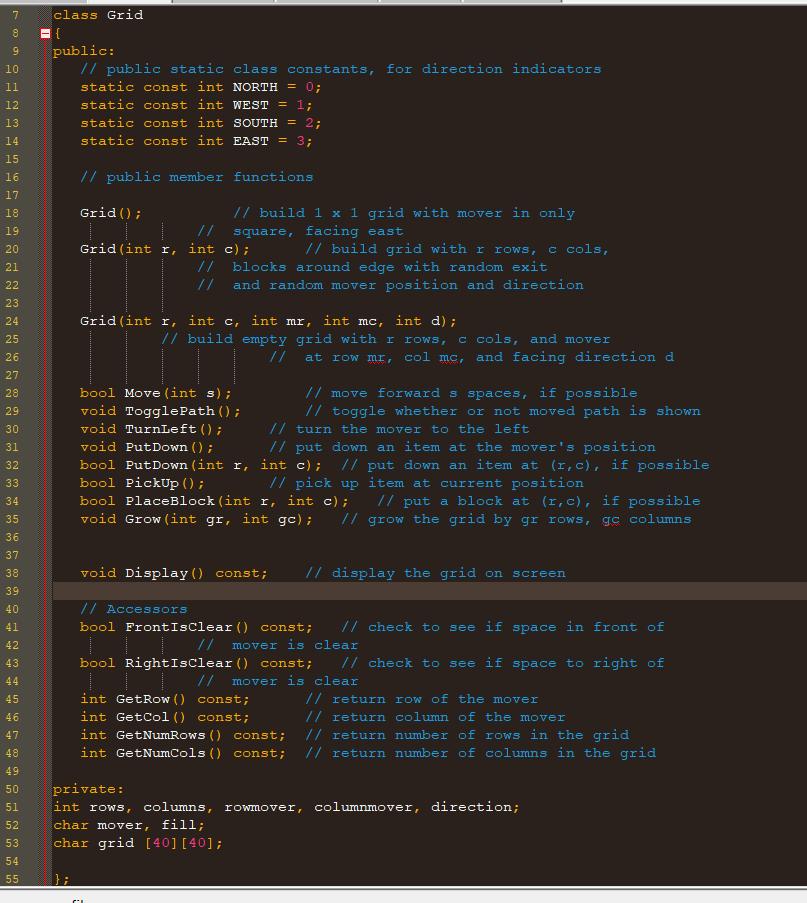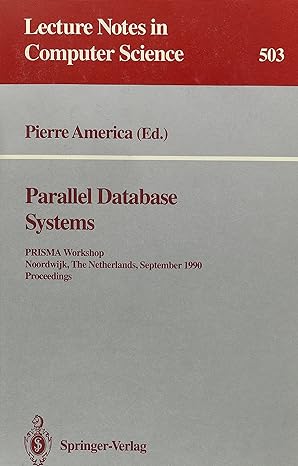Question
You will write a class called Grid, and test it with a couple of programs. A Grid object will be made up of a grid
You will write a class called Grid, and test it with a couple of programs. A Grid object will be made up of a grid of positions, numbered with rows and columns. Row and column numbering start at 0, at the top left corner of the grid. A grid object also has a "mover", which can move around to different locations on the grid. Obstacles (which block the mover) and other objects (that can be placed or picked up) are also available. Here is a sample picture of a Grid object in its display format:
0 . . . This is a Grid object with 4 rows and 4 columns (numbered 0 - 3). . . > . The mover '>' is at row 1, column 2, facing east. . . . . The obstacle '#' is at row 3, column 1 . # . . The other item '0' is at row 0, column 0
The @ character indicates that the mover and an item (0) currently occupy the same position on the grid.
Program Details and Requirements
1) Grid class
You must store the grid itself as a two-dimensional array. Maximum grid size will be 40 rows and 40 columns. (Note that this means dynamic allocation will NOT be needed for this assignment).
Meaning of Grid symbols
. empty spot on the grid 0 an item that can be placed, or picked up # a block (an obstacle). Mover cannot move through it mover facing EAST ^ mover facing NORTH v mover facing SOUTH @ mover occupying same place as item (0)
A printed space ' ' in a grid position represents a spot that the mover has already moved through when the path display is toggled on
Member function descriptions
- Grid()
The default constructor should create a 1 x 1 grid, with the mover in the only position, facing EAST - Grid(int r, int c)
The two-parameter constructor will accept two integers, representing rows and columns. Create a grid with r rows and c columns. If either of these is less than 3, default to 3. If either is greater than the max number of rows or columns, default to the max. This grid should be built such that blocks are placed all around the edge, with one random exit (i.e. with no block). The mover should be in a random position and facing a random direction within the grid. When setting up the randomness, make sure each possibility has an equal chance of happening. For example, the random direction has 4 possibilities, so each one should happen about 25% of the time. For the random exit, it will be sufficient to pick a random wall first, then pick a random location on that wall (note that the exit cannot be in a corner spot).You'll need the library cstdlib for the srand and rand functions. While it's not normally the best place to do it, you can go ahead and seed the random number generator here in the constructor in some appropriate way so that it's different for seperate program runs.
- Grid(int r, int c, int mr, int mc, int d)
This constructor (5 parameters) takes in the following information, in this order:- number of starting rows for the grid (if out of range, adjust like in the 2-parameter constructor, although minimum in this case is 1)
- number of starting columns for the grid (if out of range, adjust like in the 2-parameter constructor, although minimum in this case is 1)
- The starting row position of the mover (if out of range, adjust to the first or last row, whichever is closer)
- The starting column position of the mover (if out of range, adjust to the first or last column, whichever is closer)
- The starting direction of the mover
- Display()
This function should print out "The Grid:" on one line, then output the full grid below it -- place spaces between columns so that outputs line up more evenly. End with a newline (so that any next output will be on a separate line). If the path setting is toggled to ON, then any position the mover has already moved through should show up blank. If the path setting is toggled to OFF, then all empty grid spaces show up as dots '.'
For description of the path setting, see the funtion TogglePath() below - TogglePath()
This function, when called, should reverse whatever the current "path" setting is. The path setting can be either ON or OFF. If it's ON, it means that displays of the grid should indicate where the mover has been by showing those positions as spaces. If the path is OFF, then all blank spots on the grid show as the dot character '.' no matter what. The initial default setting for any grid should be ON. - Simple Accessors
These are accessor functions that should return the requested information:- GetRow() should return the current row of the mover
- GetCol() should return the current column of the mover
- GetNumRows() should return the number of rows in the grid
- GetNumCols() should return the number of columns in the grid
- Predicate functions
These two functions return boolean values (true or false) to answer simple questions:- FrontIsClear() should return an indication of whether the space in front of the mover is clear (i.e. not blocked)
- RightIsClear() should return an indication of whether the space to the right of the mover is clear (i.e. not blocked)
- Placing blocks and/or items
These functions involve placing things on the grid:- PutDown(): This function should place an "item" at the current location of the mover. If the location already contains an item, then nothing changes (i.e. the item is still there)
- PutDown(int r, int c): This function should place an "item" at position (r,c) where r is the row and c is the column. This function should return true for a successful placement, and false for failure. For successful placement, the position has to exist within the grid boundaries and not already contain a block or another item. (It can, however, be placed in a spot where only the mover is located).
- PlaceBlock(int r, int c): This function should place a "block" at position (r,c) where r is the row and c is the column. This function should return true for a successful placement, and false for failure. For successful placement, the position has to exist within the grid boundaries and be an empty space (i.e. not containing a block, an item, or the mover)
- PickUp()
This function should pick up the "item" at the mover's position. This means removing it from the grid. This function should return true for a successful pick-up (i.e. the item is at the mover's current position), and false for failure (there is no item there). - Move(int s)
This function should move the mover forward, in the current direction, for s spaces. Return true for success, false for failure. A successful move must be a positive number of spaces, must remain on the grid, and must not attempt to move through a "block". On a failed move, the mover should remain in the original position. (i.e. the move must be all or nothing, based on the number of spaces given by the parameter). - TurnLeft()
This function will cause the mover to turn 90 degrees to the left, from whichever way it is currently facing. (example: if the mover is facing NORTH, then TurnLeft() will make it face WEST). - void Grow(int gr, int gc)
This function should increase the size of the grid by gr rows and gc columns. If the increase causes either the number of rows or columns to exceed the maximum, simply set that (rows or columns) to the maximum. The grow should not change the current position of any item, mover, or block on the grid.
General Requirements:
- All class member data (other than the provided static constants) must be private
- As your only output in the Grid class is the Display function, your output should match mine exactly. (i.e. if I check your output against mine with the "diff" command, there should be no differences in the output of a grid).
- No global variables, use const in all appropriate places, don't #include .cpp files, document your code.
- You may use the iostream library, as well as any of the basic C function libraries. You'll probably want to take a look at ctime and cstdlib for setting up random number generation
- Do not use any C++11 - only features
Header file:
8 7sg01 9 10 11 12 13 14 234567 15 16 17 18 = { class Grid public: // public static class constants, for direction indicators static const int NORTH = 0; static const int WEST = 1; static const int SOUTH = 2; static const int EAST = 3; // public member functions // build 1 x 1 grid with mover in only square, facing east Grid(); 19 // 20 Grid (int r, int c); 21 // // build grid with r rows, c cols, blocks around edge with random exit 22 23 24 25 26 27 28 bool Move (int s); 29 void TogglePath(); 30 void TurnLeft(); 31 void PutDown (); 32 33 34 35 36 37 38 void Display () const; // and random mover position and direction Grid(int r, int c, int mr, int mc, int d); // build empty grid with r rows, c cols, and mover at row mr, col mc, and facing direction d // move forward s spaces, if possible // toggle whether or not moved path is shown // turn the mover to the left // put down an item at the mover's position bool Put Down (int r, int c); // put down an item at (r, c), if possible bool PickUp (); // pick up item at current position bool PlaceBlock (int r, int c); // put a block at (r, c), if possible void Grow (int gr, int gc); // grow the grid by gr rows, gc columns // display the grid on screen 39 40 41 42 43 44 45 int GetRow() const; 46 int GetCol () const; // Accessors bool FrontIsClear () const;B // check to see if space in front of || | // mover is clear bool RightIsClear () const; // check to see if space to right of mover is clear // return row of the mover // return column of the mover 47 int GetNumRows () const; 48 49 50 51 int GetNumCols () const; private: int rows, columns, rowmover, columnmover, direction; 52 char mover, fill; // return number of rows in the grid // return number of columns in the grid 53 char grid [40] [40]; 54 55
Step by Step Solution
There are 3 Steps involved in it
Step: 1
The initial answer overlooked implementing the Grid class and its methods as described in the requir...
Get Instant Access to Expert-Tailored Solutions
See step-by-step solutions with expert insights and AI powered tools for academic success
Step: 2

Step: 3

Ace Your Homework with AI
Get the answers you need in no time with our AI-driven, step-by-step assistance
Get Started


